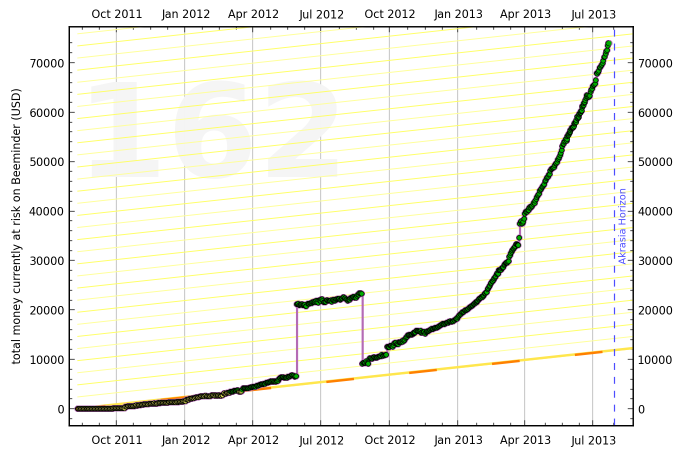
This is a guest post by Nick Winter, cofounder of Skritter and CodeCombat and author of The Motivation Hacker. He also works on Quantified Mind. We’ve mentioned Nick Winter and The Motivation Hacker before, in particular because we were so enamored with Nick’s beeminding of romantic gestures to his girlfriend. So this seems like a good time to congratulate Nick on getting married to that very girlfriend last month! As we like to say, you can do anything you set your beeminder to. Nick gives a taste of how in this article (also crossposted on blog.nickwinter.net).
It’s dark. Warm. Safe. You’re in bed, about to fall asleep. Pre-dream hallucinations of commanding a mighty bear army are playing across your sated mind. Zz — wait — what about that CrossFit Beeminder?!
You forgot. You got behind. You skipped CrossFit yesterday, but Beeminder said that was okay as long as you did it today instead. You meant to, but life happened. At this point, you think, “I am sumptuously swaddled in my favorite luxury bedding material, it’s late, and there is no way I’m going out in the street to do the workout-of-the-day in the dark, by myself, in my pajamas. And Beeminder will just charge me $5 this time. Okay, deal. Zzz.”
But I think there’s a better way to use Beeminder. When this happened to me, I didn’t even have to think about what to do; I just found myself out there grunting my medicine ball against a telephone pole and jumprope-sprinting into gloomy rosebushes. [1] It wasn’t even worth considering losing my wager over the tiny matter of some physical discomfort. What wager? Not money — just the certainty that I will always do what I promise myself I will do.
See, the real cost of failing a goal is not the loss of your Beeminder pledge money. It’s the loss of confidence that you will meet all future goals that you perceive as similar to the current goal. You will trust yourself less. And because the motivation to pursue a goal is largely based on your confidence of success, that blow to your confidence will demotivate you, making you more likely to fail. You can easily get into a failure cycle and have to abandon hope in any goal-setting mechanism that seems similar to Beeminder (or to the Beeminder-before-you’re-actually-risking-$810). [2]
“Use success spirals to build ever more confidence.”
Lame, right? But think about the converse. Every time you succeed with Beeminder, you become more confident in succeeding at goals you put into Beeminder. You gain even more confidence when you succeed at harder goals. If you play it right, you can use the research-backed technique of success spirals to build ever more confidence to succeed at ever harder goals to build ever more confidence until you can do arbitrarily hard things, like saving the world, or lifting a car over your head, or whatever. [3]
The confidence damage from failing is still huge compared to the confidence boost from succeeding, so to do success spirals right, you don’t ever want to fail a goal. But how can you completely stop failing when you’re starting off as a normal human who wins some and loses some? Just trying harder isn’t going to work.
There are many tricks to becoming a fail-proof superhuman, many of which I detail in my book, The Motivation Hacker. It’s about using precommitment, Beeminder, and other tricks to accomplish an insane number of goals all at once. (I wrote it as a clever precommitment strategy to get myself to accomplish said insane goals, one of which was writing the book.) I’ll describe a few of these tricks that relate to Beeminder.
First, make Beeminder easier. Perform triage on goals and habits you’re not confident about. Keep the ones you know you can do in Beeminder. For the rest, either take them out of Beeminder until later, or make them easier. Turn “study Chinese for half an hour a day” into “study Chinese for at least one second, five days a week.” Make them input-based (“write in my journal”) instead of output-based (“come up with two good ideas”). Make sure you’ll win.
Part of this is making sure that you remember to check Beeminder and plan your goal completion efforts accordingly. I used to have problems remembering to enter the data, or forgetting what I had to do, because I just hadn’t looked at Beeminder or read my email. Now I have every active Beeminder goal in a bookmark folder that automatically opens in a bunch of new tabs every night so that I can enter data and make sure I’m on track.
Another part is making sure that you never lie to Beeminder. Okay, maybe you wouldn’t out-and-out falsify data — but if you had gone to yoga instead of CrossFit that day, well, at 11:30 PM, you might think, hmm, maybe that counts? Does it? Well, what did you write for the fine print on your CrossFit goal? Didn’t think of this scenario? Right.
Experts at CFAR recommend practicing the mental art of Murphyjitsu: imagining everything that can possibly go wrong that would lead to failing the goal, and then outplanning Murphy. “I’m going to do CrossFit three times a week” should immediately lead to problems and solutions like:
- “Which days?” → “Mondays, Wednesdays, and Fridays, at 5:30 PM, after work, with an alarm set, and with my workout clothes always in my car.”
- “What if I can’t go during gym hours?” → “If I can’t make CrossFit, then any exercise of equal or greater intensity and duration will suffice.”
- “What if I’m sick?” → “I don’t go if I’m too sick to go to work, otherwise I go.”
- “What if I’m, like, really really tired though?” → “I go anyway but take it easy if I need to.”
- “What if I’m injured in a car accident?” → “Obviously don’t worry about it. Also, I need a first aid kit in my car.”
But you still want to do some hard goals now, before you’ve had a long time to build up your success spiral. Life would be boring if you never tried to do anything you weren’t confident you could do. So here’s what you do: set one hard goal. Go ahead and make it scary-hard, until you feel nervous just thinking now about writing soon about committing to do it three months from now. Yeah, that’s it.
“The rest will be easy, because you already know you’re going to win.”
Now make yourself sure that you’ll succeed. Use every motivation strategy you know, every trick in the book. Blog about how you’re going to do it. Tell everyone you know. Plan for all possible failure conditions and set up subgoals to defend against them. Put an insane amount of money on the line with Beeminder using Beeminder’s premium subscription feature to jump to any pledge level. You can be done planning and precommitting in fifteen minutes, and you’ll feel confident about that goal that just seemed so hard it was scary. Cheerful, even. Excited, yes. Motivated. After all, you just did the hard part. The rest will be easy, because you already know you’re going to win.
For the hardest goals in my book, I did this. As hilariously terrified of heights as I am, I decided to go skydiving, and to get myself to do it happily instead of in constant panic, I did all these things and also pledged $7290 on Beeminder (with another $7290 on finishing the book within three months). This led to a funny anomaly last summer in a meta graph for Beeminder itself:

It was almost eerie how well it worked. I wasn’t afraid during the plane’s ascent or even when I went to jump out of it. Then I actually jumped and it was even worse than I had imagined — I couldn’t decide whether to pass out or throw up. Well, bad goal. But at least it helped build up my trust in myself!
I present this always-succeed strategy based both out of my own experiences doing twenty-seven Beeminder goals over the past couple years and on plenty of psychological research on willpower and motivation tricks. I’m not saying there aren’t other ways to do it, but it’s not like I just made this stuff about success spirals up, either.
Don’t build the habit of failing at Beeminders. Build the habit of trusting yourself to do what you said you would do. Then, after you’ve succeeded at everything without ever paying $5 to the beautiful Beeminder bosses, you can just donate to them instead. [UPDATE: Donating to Beeminder isn’t a thing anymore but we’ll leave the link for posterity.]
Thanks to Leah Libresco for noticing the travesty that was the lack of a guest post by Nick Winter on the Beeminder blog.
Footnotes
[1] Actual blood and sweat, not just a figure of speech! But no tears.
[2] These failure cycles can happen with anything, not just Beeminder. It’s just worse to lose a powerful tool like Beeminder than it is to lose one like “wearing a rubber band on my wrist”.
[3] When you can do anything, the hard part is figuring out what’s actually worth doing.